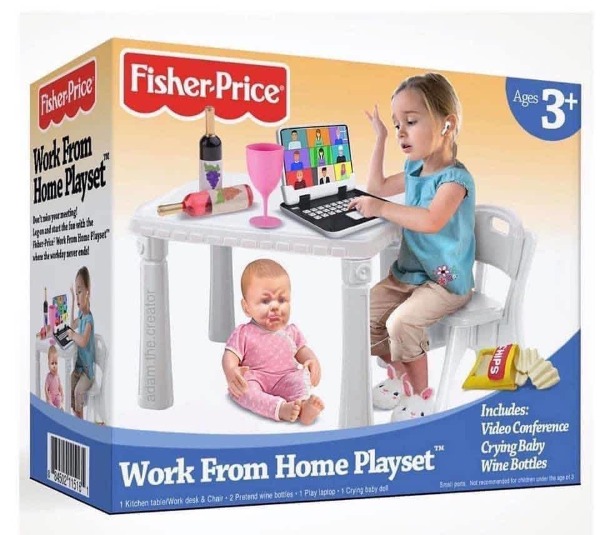It is unfortunate that the emergency move to online classes in March 2020 is often being seen as the definition of online learning. This is especially true for administrators, faculty, students. parents and the general public who had no experience with it previously. I would say that what is being offered this fall should be of a higher quality if schools used the spring experience and a summer of planning to prepare for the possibility of being fully online again. perhaps the perceptions of spring will be improved.
In a journal article that I am working on now, I say something that may not be supported by research but is supported by every faculty member I have talked to for the article: It is easier to move a good online course to a face-to-face (F2F) format than it is is to take a good F2F course and put it online. Many articles have appeared this year saying that the elements of a good online course are essentially the same as a good F2F course.
For example, if I am designing a brand new online course, I will be including all the "handouts" I would use in-person but also ones I wouldn't have included in creating a new F2F course. For example, in-person I might take 15 minutes to explain to students an upcoming assignment. For the online version, I will need that explanation in a document or as an audio/video file. If my online course is ever used to teach F2F having that explanatory document or video available for students who want to review it again after class and especially for students who missed the class session would be very useful. For the online version, I will need to create "lectures" that are chunked into smaller segments. For he F2F class, I might use those mini-lectures to flip the classroom as before class "reading" assignments. For the online course, might even rethink my entire approach to lectures.
One thing we learned from the rise of MOOCs was that there were a lot of people who wanted to learn but had no interest in credits or a degree. They took courses to learn what they wanted to learn and most of the time were not even interested in using all of the course or "finishing" the course as we would expect in traditional courses or training. This was initially the biggest criticism of MOOCs - students did not complete the course - but we came to see that completion was not an objective for most of these learners.
Skills and career advancement are the primary motives for many nontraditional learners, and online courses allowed that with a number of advantages. While in some jobs an additional degree or a certificate can mean advancement in salary and position, you can also "move up" by acquiring new skills. Online courses, degrees and certificates allow learners to continue working while they study.
Pre-pandemic, Santa Clara University surveyed hundreds of distance learners about how online learning impacted them and more than 50% of respondents recognized and appreciated the benefits of online classes.
Traditional and non-traditional learners can take online classes and the advantages apply to all. Some of the most often mentioned advantages are:
- flexibility in scheduling (most of my online graduate students have been working full- or part-time)
- lower costs
- options for preferred learning spaces
- options to take courses from other campuses or institutions
- self-paced learning
- technology and other skills learned by being an online learner
Flexibilty includes MOOCs and other offerings that allow those seeking a degree, credit, a certificate or skills advancement to start a course immediately. Even traditional programs with a 16-week structure might also offer accelerated eight-week courses. This accelerated course should have the same academic requirements and only works well for learners with no significant work or family obligations. They are sometimes offered in "intersessions" between semesters when students may be taking only one or two courses.
Some terms that have become much more familiar this year in the online learning experience are asynchronous, synchronous, hybrid, and HyFlex. Asynchronous refers to a fully-online course that does not hold scheduled meetings and students complete work at convenient times but must still have assignment deadlines. Synchronous courses, like on-campus courses, have set meeting times where the instructor conduct classes using a video conferencing service. Hybrid courses offer a combination. A course might meet once a week synchronously (on-campus or online) and the rest of the time asynchronously online. A fully HyFlex course (AKA converged learning) offers the option of F2F attendance as well as a synchronous offering of that live class session and a recorded version that can be used asynchronously.
Although most online courses run asynchronously in order to provide maximum scheduling flexibility, some also offer or require learners to participate synchronously at set times or meet with an instructor during virtual office hours. This year, I am seeing more schools offer the options of hybrid or HyFlex courses that combine online and F2F which can increase or decrease the flexibility of being fully online.
There can be cost advantages with taking online classes. The caveat to this is that in most of higher education, online learners pay the same per-credit tuition rate as on-campus learners. There are exceptions with MOOCs, certificates, and a few fully-online degree programs. An overlooked cost advantage is that the fully online student saves on not needing campus housing or meal plans and on commuting and parking costs.
Students can also save money by using cheaper digital textbooks. But the real saving there occurs when faculty embrace using Open Textbooks (generally available for free) and other open resources. I have found that faculty in designing online courses are much more likely to consider those resources than F2F instructors.
The learning space for the online student can be their dining room table, home office, work office during lunch, a local library, a coffee shop, or a park on a nice day. "Learning styles" may have fallen out of favor but clearly each of us have ways of learning and settings where we learn best. I write notes, drafts, and final versions directly on my laptop. My wife likes to spread out paper notes and references on a big table and work on her tablet.
One of the big attractions to MOOCs was that it allowed you to take courses from anywhere in the world. A student at a small community college could take a course in artificial intelligence offered by Stanford - an opportunity never available before. I took about a dozen free courses online back in 2012 when the MOOC was a hot topic even though I have no need or desire to acquire additional certifications or degrees. I took them from elite universities in the U.S. and beyond that I never had the opportunity to even consider for my own degrees.
Not having to be restricted by geographic location means attending an elite school or finding the best professor for a subject doesn't require relocating and possibly (in the MOOC option) not paying any tuition.
Anyone who has taught or learned online has probably discovered that they have learned technical skills that were not part of the formal course curriculum. Many of these skills will be needed in jobs, such as learning new software suites, doing research online, communicating by using discussion boards, and teleconferencing.
The advantages of online learning are real. They are best appreciated when the instructor learner has made the choice to learn online. That was not the situation in March of this year, but hopefully, it has led schools, faculty, and students to learn by necessity how to learn more effectively in the online world.
Will education after 2020 be "forever changed"? I doubt it. The pandemic may have been a seismic event, but moving the tectonic plates of education is very difficult.
 Traditionally, "work" was described as a full-time worker with set working hours, duties and benefits. But the definition of work has changed more rapidly in the past 20 years due to changing economic conditions and continued technological advances. A new labor force characterized by independent and contractual labor has emerged.
Traditionally, "work" was described as a full-time worker with set working hours, duties and benefits. But the definition of work has changed more rapidly in the past 20 years due to changing economic conditions and continued technological advances. A new labor force characterized by independent and contractual labor has emerged.

 In the 2017 book,
In the 2017 book, 

 I received another query today about whether I accept
I received another query today about whether I accept 